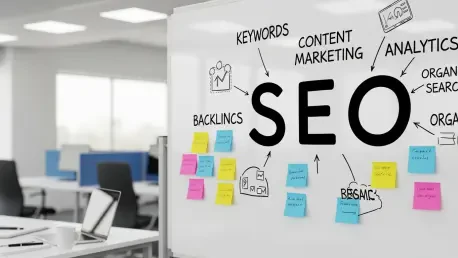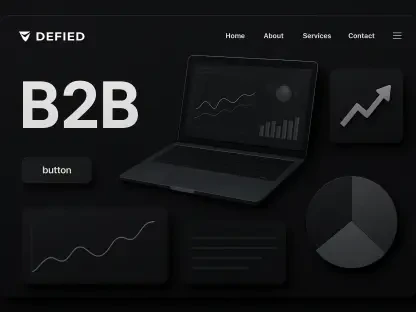Setting the Stage: A Seismic Shift in Digital Search Dynamics
Imagine a digital landscape where the once-reliable flood of website clicks has dwindled to a trickle, yet each remaining interaction holds unprecedented value for conversions. This is the reality of Search Engine Optimization (SEO) in 2025, a year marked by a profound transformation dubbed the Great Normalization. This market analysis aims to dissect the critical shifts in SEO strategies, driven by artificial intelligence (AI) and evolving user behaviors, that are redefining how businesses achieve online visibility. The importance of understanding these changes cannot be overstated, as brands that fail to adapt risk fading into obscurity in an increasingly competitive digital arena.
The purpose of this analysis is to provide clarity on the forces reshaping SEO, from the decline of low-value traffic to the rise of intent-focused engagement. It seeks to equip marketers and business leaders with actionable insights to navigate this new terrain. By examining current trends, data-driven observations, and future projections, this report offers a comprehensive view of a market in transition. The stakes are high, as the integration of AI into search continues to alter the rules of the game, demanding a strategic pivot toward relevance and quality.
In-Depth Market Trends and Projections
The Collapse of Top-of-Funnel Traffic: A Market Correction
One of the most striking trends in the SEO market today is the significant erosion of top-of-funnel (ToFu) traffic, once a cornerstone of digital marketing strategies. Data across industries like cybersecurity and marketing technology indicates traffic declines of 55-70% for generic content such as educational blogs and glossary pages. Google’s algorithm updates over recent years have targeted mass-produced, low-value content, while AI tools like large language models (LLMs) provide direct answers, reducing the need for users to click through for basic information. This correction signals a market shift away from volume-driven metrics.
This decline challenges long-standing practices, particularly among B2B sectors that relied on broad, informational content to capture leads. Many agencies and brands still grapple with outdated mindsets, equating high traffic with success despite minimal conversion rates. However, the data suggests a silver lining: the loss of irrelevant clicks pushes the market toward content that aligns with user needs, fostering a healthier digital ecosystem. The challenge lies in reallocating resources to more impactful strategies.
Looking ahead, projections indicate that ToFu content will continue to lose ground through at least 2027, as AI-driven search behaviors further dominate. Businesses must pivot to content that serves specific, high-intent queries to remain competitive. This trend underscores a broader market recalibration, where success hinges on quality engagement rather than sheer numbers, setting the stage for deeper strategic adjustments.
AI’s Dual Role: Disrupting and Enhancing Market Dynamics
AI stands as a pivotal force in the SEO market, acting as both a disruptor and a catalyst for opportunity within the Great Normalization. By summarizing consensus information, AI contributes to zero-click searches, slashing organic traffic for basic queries. However, industry studies reveal that visitors arriving through AI-driven search convert at higher rates, as LLMs equip users with comprehensive background knowledge before they engage with a website. This results in fewer but more qualified leads entering the funnel.
The market impact of AI extends to how content is prioritized. Unlike traditional SEO, which focused on ranking for broad keywords, AI search favors prompts requiring real-time data or specific citations, often referencing branded or nuanced content. Brands producing generic material risk obsolescence, while those crafting middle-of-funnel (MoFu) comparison pages or bottom-of-funnel (BoFu) decision guides stand to gain visibility. This dynamic illustrates AI’s role as a great equalizer, leveling the playing field for those who adapt.
Future projections suggest that AI’s influence will deepen, with technological advancements likely to enhance zero-click searches while rewarding authoritative, unique content. Regulatory changes around data privacy could also reshape AI’s application in search, particularly in regions with stringent policies. The market must brace for a landscape where adaptability to AI’s evolving capabilities becomes a core competitive advantage, driving innovation in content creation.
Branded Content and Regional Variations: Emerging Market Opportunities
Beyond AI’s overarching impact, the SEO market is witnessing a rise in the importance of branded content and regional nuances. Research highlights a surge in homepage and branded traffic as reputation and ecosystem visibility become critical differentiators in an AI-dominated environment. In markets like Europe, where privacy laws influence search patterns, or in emerging economies with mobile-first user bases, tailored strategies are proving essential for maintaining relevance.
Industry insights emphasize the value of content that triggers LLM grounding, where AI cites specific brands or sources, over generic keyword targeting. Misconceptions persist that all traffic loss is detrimental, yet much of the lost ToFu traffic was irrelevant to conversions, freeing up focus for more impactful efforts. Regional variations add complexity, as search behaviors differ significantly based on cultural and technological factors, urging marketers to adopt localized approaches.
Projections for the coming years indicate that branded content will grow as a key market driver, with businesses investing in thought leadership and ecosystem presence to stand out. Emerging markets, particularly in Asia and Africa, are expected to shape global trends as mobile search continues to dominate. Tapping into these opportunities requires a nuanced understanding of both global shifts and local contexts, positioning agile brands for success in a fragmented market.
Evolving Metrics and Diversification: Redefining Market Success
Another defining trend in the SEO market is the shift from traditional metrics like keyword rank tracking to prompt monitoring in AI-driven search environments. Only prompts necessitating grounded responses or real-time references hold value, moving the industry away from vanity metrics such as impressions. This evolution reflects a market-wide push toward attribution-focused measurements that directly correlate with business outcomes, reshaping how success is evaluated.
Diversification across marketing channels is also gaining traction as organic search becomes less predictable. Brands are increasingly turning to platforms like LinkedIn, YouTube, and social media advertising to build integrated marketing ecosystems. This trend mitigates the risks posed by declining organic clicks and AI-driven disruptions, creating a more resilient approach to digital visibility. The market is witnessing a convergence of SEO with disciplines like content marketing and public relations.
Looking forward, the integration of SEO with broader marketing strategies is expected to intensify, with diversified channels playing a larger role in lead generation. By 2027, the market may see AI tools evolve to better reward depth over volume, offering potential for brands that prioritize unique insights. Success in this evolving landscape will depend on a willingness to embrace new metrics and cross-channel strategies, ensuring flexibility in an unpredictable market.
Reflections and Strategic Pathways Forward
Reflecting on the analysis, the Great Normalization in SEO marks a pivotal turning point for the digital marketing landscape. The decline of top-of-funnel traffic, coupled with AI’s transformative dual role, redefines market priorities, steering focus toward intent-driven engagement and branded visibility. Regional nuances and the shift to diversified channels further highlight the complexity of adapting to a shrinking but more valuable click inventory. These findings underscore the necessity of strategic evolution in a rapidly changing environment.
As a next step, businesses are encouraged to abandon outdated traffic-chasing tactics and invest in high-intent content like comparison guides and decision-focused pages. Leveraging tools to track attribution rather than superficial metrics becomes a recommended practice for aligning efforts with tangible outcomes. Building a robust brand presence through thought leadership and exploring untapped regional opportunities offer pathways to differentiate in a crowded market. Ultimately, the journey ahead demands a commitment to delivering authentic value, ensuring that digital strategies resonate deeply with target audiences in an era of heightened relevance.









